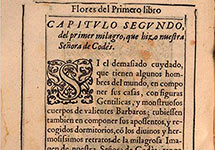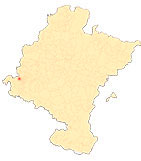Sanctuary of Nuestra Señora de Codés
By Pilar Andueza Unanua
The spread of a devotion: the first miracle of Our Lady of Codés
Despite the uncertain or legendary origins of the image, it was from the Modern Age when it seems that devotion to the Virgin of Codés increased, especially since the 16th century, becoming an important center of pilgrimage for the people of the Merindad of Estella, but also Castilian (Alava and La Rioja). A fact narrated by Amiax in his work was fundamental for this: the first miracle attributed to Our Lady of Codés.
This miracle corresponds to a tradition that has come down to our days and that year after year the brotherhood of San Juan de Torralba del Río commemorates on June 24. Amiax narrated that in 1523 there were bandits near Cábrega, in the Berrueza, who robbed and assaulted the villages in the area. They took refuge in the castle of Monicastro or Malpica and their leader was Juan Lobo. The neighbors defended themselves through the aforementioned brotherhood that, at the ringing of the bell, gathered its members to pursue the bandits. On one occasion the bandits robbed a man and took him prisoner to the castle, imposing thick boards as shackles. While he remained there, the prisoner prayed to the Virgin of Codés, and so one day the miracle was worked: he appeared asleep at the gates of the Shrine of Our Lady of Fair Love of Codés, where some shepherds found him and woke him up and learned his story. The shackles were hung there as a votive offering and from then on there was a hermit in that place who, once the news spread, began to receive pilgrims, definitively starting the devotion to Our Lady of Codés. At the same time, the bandits were captured and Juan Lobo died from a spear thrown by the knight Mosén Pedro de Mirafuentes, neighbor of Otiñano. Precisely this legendary episode is the one that every year the same brotherhood commemorates chasing Juan Lobo. Logically over time, as is typical of intangible heritage, religious elements (dawn, mass and procession) have been mixed with other festive elements such as dances and gastronomy.
AMIAX, J. de, Ramillete de Nuestra Señora de Codés, Pamplona, By Carlos Labayen, 1608.
History of Our Lady of Codés. Sencillos apuntes sobre Codés, Logroño, Cofradía Administradora del Santuario de Nuestra Señora de Codés, 1939.
ANDUEZA UNANUA, P, "El Santuario de Nuestra Señora de Codés: historia, arte y devoción", in FELONES MORRÁS, R. (coord.), En montes y valles. Santuarios en Tierra Estella, Estella, Cofradías de Nuestra Señora del Puy, Nuestra Señora de Codés y San Gregorio Ostiense, 2017, pp. 52-65.
AZANZA LÓPEZ, J. J., Arquitectura religiosa del Barroco en Navarra, Pamplona, Institución Príncipe de Viana, 1998.
GARCÍA GAINZA, M. C. and others, Catalog Monumental de Navarra. Merindad de Estella II**, Pamplona, Institución Príncipe de Viana, 1983.
ITÚRBIDE DÍAS, J., Between the Renaissance and the Baroque: Ramillete de Nuestra Señora de Codés (A bouquet of Our Lady of Codés)Piece of the month. Chair de Patrimonio y Arte navarro, 2016.
ORDOÑEZ, V., Santuario de Codés, Colección Temas de Cultura Popular nº 343, Pamplona, Diputación Foral de Navarra, 1984.











